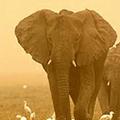 位於西非的查德宣佈,指定其國境南部包括了氾濫平原(floodplains)、湖泊、河流以及水塘等的一片廣闊綿亙地區,作為拉姆薩公約(Ramsar Convention)之下的「國際級重要溼地」,以提高此僻壤地區受到保育的機會。查德南部地區是著名的難民庇護所,收容來自該國東部──蘇丹達佛(Darfur)軍事衝突區的難民。另外,為了保護這片溼地,查德也和其南部接壤的中非共和國共同合作。
位於西非的查德宣佈,指定其國境南部包括了氾濫平原(floodplains)、湖泊、河流以及水塘等的一片廣闊綿亙地區,作為拉姆薩公約(Ramsar Convention)之下的「國際級重要溼地」,以提高此僻壤地區受到保育的機會。查德南部地區是著名的難民庇護所,收容來自該國東部──蘇丹達佛(Darfur)軍事衝突區的難民。另外,為了保護這片溼地,查德也和其南部接壤的中非共和國共同合作。
拉姆薩溼地公約是一項政府間的框架條約,希望藉此促進溼地保育並善用其資源。拉姆薩公約係1971年在伊朗城鎮拉姆薩簽署,是世界上最早的國際保育條約,它是唯一一個為了特定生態系統所設立的環境條約,也是第一個結合自然保育與自然資源永續利用的政府間條約。
拉姆薩公約秘書處的史高丹尼畢歐(Lucia Scodanibbio)指出,查德南部溼地對周遭野生生物扮演著重要角色,提供數種遷徙水鳥繁殖的場地,支持著河馬、豹、大象和各種羚羊的生存。它也是一些魚類族群的產卵和培育溫床,在洪水控制、地下水挹注、沉積物堆積與水中化學物質調節等方面,也扮演重要角色。這個地方的主要威脅來自盜獵、石油探測、過度放牧、違法起火和殺蟲劑污染。
2005年11月間在烏干達首府康培拉(Kampala)所舉行的第9屆拉姆薩公約締約國會議上,大會發起一項名為「查德溼地」(ChadWet)的區域行動計畫;這次指定查德南部作為國際重要溼地,則是此計畫的一部份。
除了將該處劃設為國際重要溼地外,還將執行一項「全球環境基金查德湖盆地方案」(GEF Lake Chad Basin project)架構下的試驗計畫。根據「全球環境基金」(GEF)的分析,儘管當地政府尚未有能力提供強力的保護,但幸賴此區地處偏遠、不易到達,意謂著非洲多種重要的野生動植物,包括受到威脅的和瀕危的物種,有機會可留存下來。
GEF預測,這個區域未來可能會吸引越來越多來自其他地方的人口,長期下來將增加對生物多樣性和生態系統的壓力。此外,山區的土壤侵蝕、水資源管理(尤其是地下水問題),也是必須關心的議題。
 The West African country of Chad has announced designation of a vast stretch of floodplains, a lake, rivers, and ponds on its southern border as a Wetland of International Importance under the Ramsar Convention, improving the opportunities for conservation in this remote area. Known worldwide for its role as a shelter for refugees from the conflict in Darfur, Sudan on its eastern border, Chad is protecting this wetland on its southern border with the Central Africa Republic.
The West African country of Chad has announced designation of a vast stretch of floodplains, a lake, rivers, and ponds on its southern border as a Wetland of International Importance under the Ramsar Convention, improving the opportunities for conservation in this remote area. Known worldwide for its role as a shelter for refugees from the conflict in Darfur, Sudan on its eastern border, Chad is protecting this wetland on its southern border with the Central Africa Republic.
The Ramsar Convention on Wetlands is an intergovernmental treaty which provides a framework for the conservation and wise use of wetlands and their resources.
Established in 1971 in the Iranian town of Ramsar, it is the world's oldest international conservation treaty, the only environmental treaty for a particular type of ecosystem, and the first global intergovernmental treaty to combine conservation and sustainable use of natural resources.
The site plays an important role for the surrounding wildlife, providing breeding grounds for several migratory waterbirds and supporting hippos, leopards, elephants and a variety of antelope species. It also is a spawning and nursery ground for several fish families, and plays a role in flood control, groundwater recharge, sediment trapping and chemical regulation of the waters, Ramsar's Lucia Scodanibbio writes.
The main threats to the site arise from poaching, oil exploration, overgrazing, illegal fires and contamination by pesticides.
The new designation is part of Chad's contribution to the ChadWet regional initiative that was launched at the 9th Meeting of the Parties to the Ramsar Convention held in Kampala, Uganda last November.
The new Ramsar site includes one of the pilot projects in the framework of the GEF Lake Chad Basin project. While the government has not been able to provide strong protection to these areas, according to the GEF project analysis, their remoteness and difficulty of access suggest that important populations of African wildife, including threatened and endangered species, may remain.
The GEF analysis forecasts that this region is likely to attract immigrant populations from other areas in the future, leading to increased pressure on biodiversity and ecosystems in the long run. Soil erosion in hilly areas, and water management, especially groundwater, are additional issues of concern.



